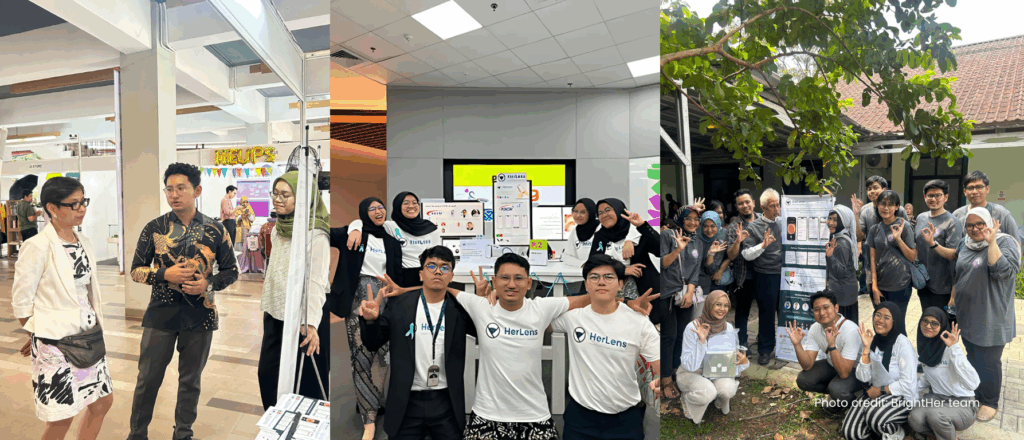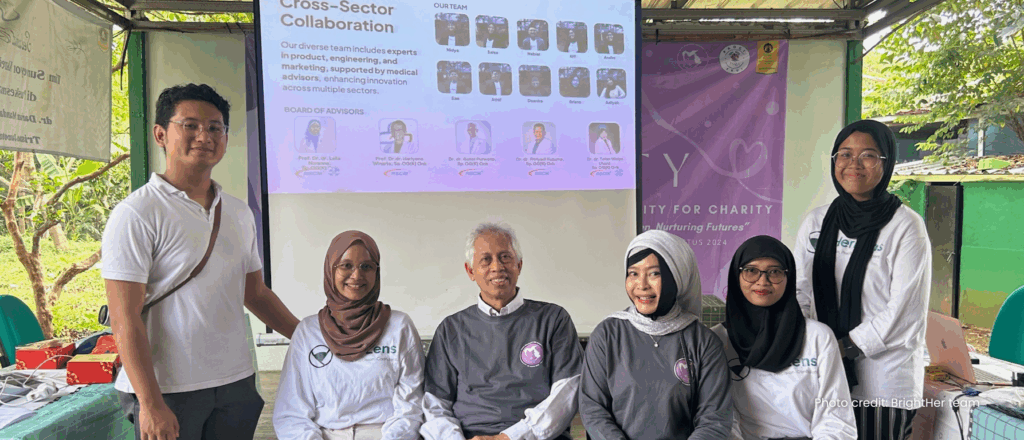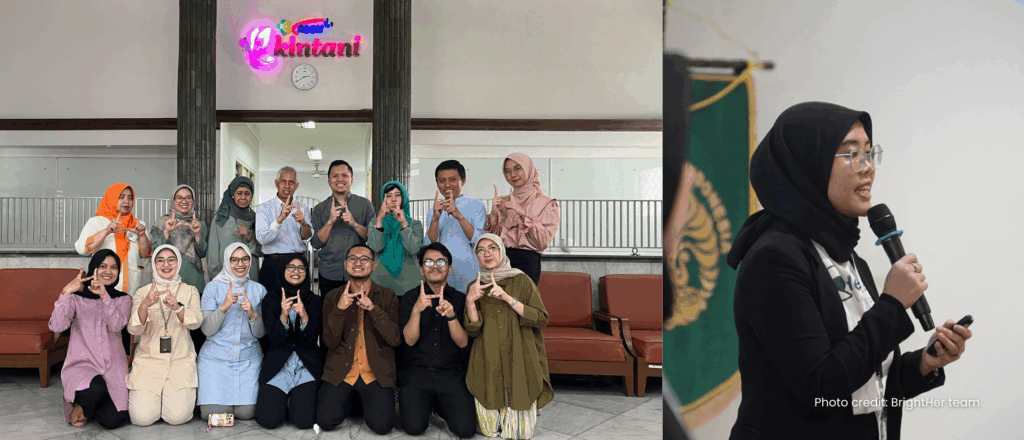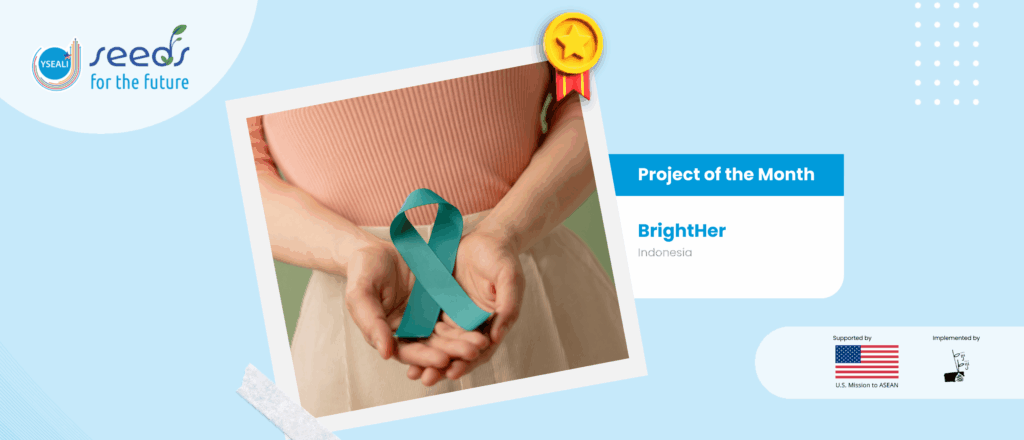About the Project
With BrightHer, we respond to serious gaps in cervical cancer screening across Indonesia by improving the way Visual Inspection with Acetic Acid (VIA)-based screenings are delivered, especially in clinics with limited resources. At the heart of the program is a simple AI-supported tool that helps frontline health workers reduce uncertainty and improve diagnostic accuracy.
Alongside it, we also train midwives and general practitioners, provide free screenings and education for over 300 women, and work with clinics to strengthen referral systems. With institutional support from RSCM and IMERI FKUI, BrightHer will soon launch a full rollout in rural Java, combining training, outreach, and on-site care in our four-day field program.
Why do you care about this specific topic/issue?
We see firsthand how low screening rates are connected to gaps in public awareness, fear, and inconsistent diagnostic practices. Although cervical cancer is largely preventable, many women miss timely detection due to limitations in the current system.
Working closely with healthcare providers, we also understand that affordable methods like VIA have variable accuracy, especially when providers lack specialized training. This insight drives their commitment to develop practical, scalable solutions that make screening more reliable, accessible, and trustworthy for women across Indonesia.
Why did you decide to start this project?

BrightHer grew out of our work at HerLens, a health-tech startup developing an AI-powered cervical cancer screening tool. We quickly realized that technology alone wasn’t enough. Many women still lack access to trained providers, and even the best tools require education, infrastructure, and trust to be effective.
We launched BrightHer to integrate innovation with public participation and healthcare delivery. Our aim is to train healthcare professionals, raise awareness, and provide screening services in both urban and rural areas. This effort runs alongside product development to ensure real-world usability and tangible benefits.
What are your goals for this project?
Our project sets specific, actionable goals to improve cervical cancer screening in Indonesia. We aim to train 50 healthcare professionals, including general practitioners and midwives, in using our AI-supported screening method and to screen at least 300 women. This strategy promotes more accurate diagnoses, better patient care, and greater awareness.
Additionally, our integrated mobile app enhances the safety, accuracy, and privacy of VIA testing by securely managing patient data and reducing reliance on informal practices. Ultimately, we seek to translate knowledge into measurable, on-the-ground improvements.
How will YSEALI Seeds help you achieve your goals?
YSEALI Seeds for the Future support has been essential in moving our project from planning to implementation. Their grant covers key operational costs such as training, equipment, transportation, and outreach, enabling us to provide free screenings to rural women.
It also helps us provide small incentives, like food packages, which encourage attendance. Beyond the funding, YSEALI Seeds for the Future backing adds credibility that opens doors with local partners. This support is key to turning our plans into real, lasting action.
What have you accomplished and implemented so far?

While our formal rollout commences in late August, our foundational groundwork is already robust. We have successfully completed pilot screenings in Jakarta in partnership with local clinics, effectively deploying our AI-assisted tool in real clinical settings. Feedback has been highly promising, with patients expressing confidence in the process and healthcare workers demonstrating enthusiasm for adopting the new methodology.
We have also secured key partnerships with clinics, medical professionals, and the Female Cancer Program to ensure broad reach. Our training curriculum, developed with experts from the University of Indonesia, is complete, and our digital infrastructure is ready. These milestones set the stage for our upcoming full-scale implementation.
What are the most significant lessons learned you’ve experienced so far?
One of the clearest lessons gleaned is that access alone is insufficient. Even when services are offered free of charge, many women exhibit hesitation to participate due to prevailing fear, stigma, or a fundamental lack of knowledge. Effectively reaching these individuals necessitates building trust, consistent communication, and culturally sensitive educational approaches.
We’ve also found that healthcare providers are willing to adopt new methods but need proper training and support to do so confidently. Providing tools is not enough; hands-on guidance and clinical backing are critical for successful integration.
Additionally, privacy and data security are major concerns. Informal practices like sharing patient images over unsecured chat groups highlight the need for secure, ethical data handling.
What are the success stories you can share with others?

Our journey has taught us that overcoming challenges like limited transportation, a shortage of trained healthcare workers, and low awareness requires more than just technology. While our AI-assisted tool helps bridge gaps in diagnosis, the bigger hurdle is building trust and changing behavior where many women are unfamiliar with screening or concerned about privacy.
One success story is seeing how our educational efforts are slowly shifting mindsets, not just about cervical cancer prevention, but also around data security and the importance of proactive health. Though the road is challenging, each small step in training healthcare workers and engaging women brings us closer to making reliable screening more accessible and accepted.
